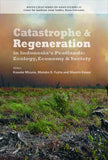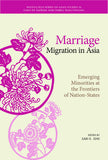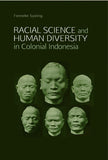News
Follow NUS Press on
Five Minutes with Samuel Ling Wei Chan May 15, 2019 09:42
I n April this year, Dr Samuel Ling Wei Chan published "Aristocracy of Armed Talent, The Military Elite in Singapore". It explores the Singapore Armed Forces by a comprehensive and in-depth examination of its elite leadership: the 170 men (and a very few women) who served or serve as flag officers, that is generals or admirals. How did Singapore build a culture of leadership for its armed forces? What role did the SAF Scholars scheme, introduced in 1971, play in forming this culture?For this edition of Five Minutes With... we turned to noted military expert and journalist David Boey, who conducted this interview and first ran it on his excellent blog on Singapore military matters, Senang Diri. Thanks to David for the interview and for giving us permission to run it on the website.
n April this year, Dr Samuel Ling Wei Chan published "Aristocracy of Armed Talent, The Military Elite in Singapore". It explores the Singapore Armed Forces by a comprehensive and in-depth examination of its elite leadership: the 170 men (and a very few women) who served or serve as flag officers, that is generals or admirals. How did Singapore build a culture of leadership for its armed forces? What role did the SAF Scholars scheme, introduced in 1971, play in forming this culture?For this edition of Five Minutes With... we turned to noted military expert and journalist David Boey, who conducted this interview and first ran it on his excellent blog on Singapore military matters, Senang Diri. Thanks to David for the interview and for giving us permission to run it on the website.
How long did it take you to write the book?
The book is a revised and updated edition of my PhD thesis. I started my studies in March 2011 but by February 2012 it was apparent that my initial topic (on military education in Australia and the US) was not tenable.
What made you press on with research on the SAF despite initial hurdles?
It was a challenge to complete a puzzle and I was focused on the task at hand. The topic is interesting to me, both in academic and general terms.
What was the most challenging aspect of the research for this book?
The most challenging aspects were access to information in terms of open source material and interviews for the specific questions that I had in mind.
How did you go about resolving the challenge(s)?
The 28 interviews were great and a blessing in terms of being able to get the work done.
Which chapter did you enjoy researching/writing most?
I must say I enjoyed them all due to the variation, focus, and information in each of the chapters.
What are the takeaways you hope the reader will glean from the book?
To appreciate the SAF in its entirety, both the good, the quirky, and the not so good.
NUS Press Highlights of 2016 December 27, 2016 10:30
While 2016 has proven to be a rather bleak and tumultuous year, we are proud to have published some books that will continue to have much bearing in the new year ahead.
ENVIRONMENT
All eyes will continue to be on Indonesia’s Peatland Restoration Agency as it implements plans of restoring peatland to prevent haze crises (like that of 2015) from engulfing the region again.
Two NUS Press books, Catastrophe and Regeneration in Indonesia’s Peatlands (edited by Kosuke Mizuno, Motoko S. Fujita and Shuichi Kawai) and The Oil Palm Complex (edited by Rob Cramb and John McCarthy) touched on some agricultural and labour challenges that Malaysia and Indonesia are facing within the oil palm industry and peatland agriculture. In his review of both books in The Jakarta Post, James Erbaugh commented that both titles “provide scholarship that elucidates the complexities of oil palm production, and the challenges presented by peatland agriculture as well as peatland restoration.”


POLITICS
Indonesia’s gubernatorial election is set to take place in February 2017 and Edward Aspinall’s and Mada Sukmajati’s edited volume, Electoral Dynamics in Indonesia will be handy for observers as it provides greater insight into the patronage systems and money politics at the grassroots level.

In the field of maritime developments: Tensions in the South China Sea will continue to have much bearing on US-China and China-ASEAN relations in 2017. Ng Chin-keong’s collection of essays, Boundaries and Beyond, provides a novel way of understanding the nature of maritime China, and the undercurrent of social and economic forces that have created new boundaries between China and the rest of the world.
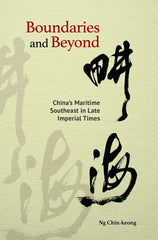
Lastly, in light of the 29th Southeast Asian Games taking place in Kuala Lumpur next year, Stephen Huebner’s Pan-Asian Sports and the Emergence of Modern Asia, 1913-1974 explores the role international sporting competitions had in shaping discourses of nationalism and development across Asian states. As one of the first major studies of the history of sports in Asia, Dr Huebner’s book provides a compelling window into the intersection between sports and politics in the region.

SINGAPORE HISTORY
The history of pre-independence Singapore remained a staple to our publishing programme this year, with Timothy Barnard’s Nature’s Colony shedding much light on the Singapore Botanic Gardens' lively history. Professor Barnard examined the Gardens’ changing role in a developing Singapore—from colonial times under the charge of several colourful Superintendents and Directors, to today, as a World Heritage Site.

On a more personal level, social work pioneer Ann Wee reminisces about her eventful life in Singapore. Her memoir A Tiger Remembers ruminates on the Singaporean family, and presents the reader with a series of charming vignettes from her life that captures the nuanced transformation of Singaporean society over the years. These intimate recollections, all told in exquisite detail and rich with insight, are testament to the vibrant cultural heritage of the nation.

We are also proud to have published Professor Kenneth Dean and Dr Hue Guan Thye's two-volume set, Chinese Epigraphy in Singapore, 1819-1911, which has been described by Claudine Salmon, Director of Research Emeritus at the French National Centre for Scientific Research (CNRS), Paris to be a "a repository of Singapore cultural and historical heritage." The collation of over 1,300 epigraphic records is a breakthrough in the telling of the Singapore story and according to Prof Dean, "such inscriptions provide snippets of what life was like in 19th and early 20th century Singapore, and capture the diverse cross-section of society at that time."

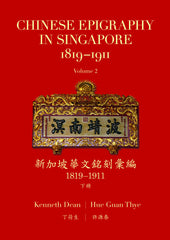
SOUTHEAST ASIAN ART HISTORY
What importance does art hold in the representation of history?
In the context of the portrayal of Southeast Asia by its colonial masters, Sarah Tiffin’s Southeast Asia in Ruins explores how the British justified colonialism through imperial art. Dr Tiffin will be speaking at the National Gallery Singapore on 25 February 2017 about British artists' portrayal of Southeast Asian civilization(s) in ruins in Stamford Raffles' The History of Java, and the role that these artists (and their work) played in Britain’s imperial ambitions in Southeast Asia.

In 2017, photographers and photojournalists will continue to play a vital role in exposing the realities of an increasingly authoritarian Southeast Asia. Zhuang Wubin’s Photography in Southeast Asia will be a useful introduction to the discourse of photographic practices in the region as his survey provides insights into the role images play in shaping Southeast Asian society, culture and politics.
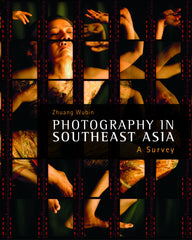
NUS Press at the 2016 ASEASUK Conference September 16, 2016 12:30
NUS Press is pleased to be part of the 2016 edition of the Association for Southeast Asian Studies in the United Kingdom (ASEASUK) Conference at the School of Oriental and African Studies (SOAS). Held over three days this weekend (16-18 September), it is set to be the largest ASEASUK conference, with over 40 panels discussing a wide variety of topics.
NIAS Press is representing NUS Press at the event and will be displaying our books. Here’s a highlight of some titles:
|
|
- Catastrophe and Regeneration in Indonesia's Peatlands: Ecology, Economy and Society
- The Oil Palm Complex: Smallholders, Agribusiness and the State in Indonesia and Malaysia
- Marriage Migration in Asia: Emerging Minorities at the Frontiers of Nation-States
- Central Banking as State Building: Policymakers and their Nationalism in the Philippines, 1933-1964
- Electoral Dynamics in Indonesia: Money Politics, Patronage and Clientelism at the Grassroots
- Tall Tree, Nest of the Wind: The Javanese Shadow-play Dewa Ruci Performed by Ki Anom Soeroto - A Study in Performance Philology
- Pan-Asian Games and the Emergence of Modern Asia, 1913-1974
- Racial Science and Diversity in Colonial Indonesia
Dr Paul Kratoska, Publishing Director of NUS Press, will be also attending the Conference.
Do drop by to find out more about NUS Press and to browse our selection!
Five Minutes with Stefan Huebner August 8, 2016 14:30
 With the Rio Olympic Games underway, we caught up with Stefan Huebner, author of Pan-Asian Sports and the Emergence of Modern Asia, 1913-1974 to discuss who was responsible for spreading Western sports across Asia, how sports came to shape the idea of Asian 'nation-states', and why sporting events continue to be an important (and very costly) tool for nation-branding today.
With the Rio Olympic Games underway, we caught up with Stefan Huebner, author of Pan-Asian Sports and the Emergence of Modern Asia, 1913-1974 to discuss who was responsible for spreading Western sports across Asia, how sports came to shape the idea of Asian 'nation-states', and why sporting events continue to be an important (and very costly) tool for nation-branding today.
How did you become interested in the connections between religion, East-West politics and sports?
During my undergraduate studies in history, I was very interested in Japan since it managed to defeat Russia in the Russo-Japanese War of 1904/05. I also wondered why China and other Asian countries became victims of “Western” (and also Japanese) colonialism and imperialism. When we talked about the book, I should say that I was at first not really interested in sports, but when I learned that the Far Eastern Championship Games had been founded by officials of the North American YMCA and supported by the US colonial administration in the Philippines, this really caught my interest. I bet most people think that the International Olympic Committee was mainly responsible for spreading Western sports in Asia and other regions, but that’s not the case. While doing some initial research, I also became very interested in development policy in Asia during decolonisation and the Cold War, which is very important to understand the postwar Asian Games and why they served to communicate the image (actually several different images) of a “rising Asia”.

How is sport related to ideas of anti-colonialism or nationalism? Do these ideas expire?
Very often athletes represent nation-states. Events can be (and some are) organised in different ways, but when the North American YMCA founded the Far Eastern Championship Games in 1913, they chose this approach. Watching athletes representing entities such as “China”, “Japan”, or the “Philippines” in the stadium or reading about them in newspapers created feelings of national belonging. Part of this was based on the YMCA’s and the US colonial administration’s experience of pitting town teams in the Philippines against each other. The intention had been that such athletic rivalry would encourage the selection of athletes based on their competence, not on clan and family relations or other factors, to maximise each team’s strength. In the process, people of different social backgrounds or even ethnicities would be integrated into the town’s team. This approach was then repeated on the regional level, meaning that people from different parts of China, Japan and the Philippines were represented in the respective “national” teams. This integrative approach certainly made it easier for spectators to identify with a team. The intention thus was not to encourage aggressive forms of nationalism (though the outcome sometimes was different), but to encourage the emergence of national civil societies. The staging of the games also regularly served to promote a certain image of the host nation—this remains true today and I doubt this will change in the near future.
Anti-colonialism, both in the form of nationalism and pan-Asianism, was closely linked to all that. Initially, the main organisers of the games were all Americans, who held these positions since there were no Asians who were equally experienced in Western sports. However, when a first generation of Asian physical educators emerged, these often felt patronised and eventually ended this “colonial” relationship between “American experts” and “Asian pupils”. Events on the international level, such as the Paris Peace Conference in 1919, also intensified anti-colonial sentiments—as a newspaper cartoon in my book shows. Seen before the background of this “Asiatisation” process, the games started to communicate the message that Asians now were in charge of a “modernisation process” in fields such as sport, public health and citizenship training that would eventually end the power asymmetry vis-à-vis the “West”.
Asian leaders in the 1910s such as JAAA president Kanō Jigorō criticised American style sports for its characteristics (“inefficient training method for shaping better soldiers and workers”), but did they also consider sports an invasion of “Western” values?
Some indeed did. Especially those Asian leaders who did not appreciate the activities of missionary groups resisted the YMCA’s Christian approach to amateur sports: “muscular Christianity”. However, not all of those Asian leaders rejected Western sports in general, but some of them claimed that they fitted well into Asian cultural backgrounds. There were, for example, Japanese sports leaders who connected Western sports to the Bushidō, the Way of the Warrior. Some of them did this to challenge the influence of North American missionary groups in Asian sports events.
Others, who were closer to the YMCA, advocated an interpretation of the Bushidō that had quite a “Western-Christian” touch. In this way, local resistance against “muscular Christianity” could be circumvented and “Western” values could still be promoted. Much more can be said about this topic, but I want to conclude with shortly mentioning those Asian leaders who eventually dominated the field: those who referred to the Olympic movement and “Olympism”. Doing this became increasingly popular, since such a secular approach to “Western” sports did not cause much resistance (after all, nobody believes in the old Greek gods anymore).
"Uncle Sam teaching the Asian children sports values"; Philippines Free Press (10 May 1919). (Image courtesy of US Library of Congress)
What was the process of penning Pan-Asian Sports and the Emergence of Modern Asia 1913–1974 like?
It is my first book, so I was very enthusiastic when it finally got published. I started working on the topic in autumn 2009 and the book came out this year, which is quite quick, I think.
During the first years I travelled a lot in Asia, Europe and North America to gather sources in various archives and libraries and to make myself familiar with the history of sports in Asia. Turning all these into a book was a fascinating process, especially when I realised how useful the concept of the “civilising mission” is to analyse the events I covered. Scrutinising the games’ connections to Asian nationalisms, pan-Asian sentiments, religious ideas and Cold War development policy was also very interesting as I noticed the tremendous changes the Games experienced over the course of 60 years. I also enjoyed working with so many images—and when my book manuscript was accepted without any revisions, I was extremely happy! Obviously, some less exciting tasks were inevitable … when things needed to be standardised, the bibliography needed to be compiled, etc.
How do you think sports have evolved in Asia in recent years? Do you think the same tensions remain?
It obviously depends on the type of event we talk about. The 18th Asian Games that are set to take place in Indonesia in 2018 is an interesting case, since the event originally was supposed to have taken place in Vietnam. Financial problems, including the question of what to do with the newly-built venues after the event is over, have been a main reason for Vietnam’s decision not to host the games and remind us of how expensive the hosting of regional sports events has become. In my book, I pointed out that the founders of the Asian Games reflected on this problem early on.
When we talk about the Olympic Games, it is remarkable that we will have the Winter Olympic Games in South Korea in 2018, and in China in 2022. Between the two events, the Summer Olympics will take place in Tokyo in 2020. This is very noteworthy, especially since all three East Asian countries have hosted Olympic events before—strictly speaking they are the only Asian countries which have hosted the Olympic Games so far. This again reminds us of the high costs of hosting such events and throws the spotlight on which countries are trusted by the International Olympic Committee to host the Games. The controversial 2010 Commonwealth Games in India comes to one’s mind as it did not set the precedent of hosting any editions of the Olympic Games.

Chinese female swimmers at the 10th Far Eastern Championship Games in 1934. (Image courtesy of Harvard Yenching Library)
Is your next research project along the tangent of politics, religion and sports?
My next book project will be on oceanic colonisation projects, such as offshore drilling, mariculture (farming of marine organisms) and floating city extensions. There is a connection to development policy, which is part of the main story in the later chapters of my book. But I will also continue working on the dynamics between politics, religion and sports. For example, I am co-organising a conference here in Singapore at the Asia Research Institute on 25–26 August titled “The Protestant Ethic and the Spirit of the Social Gospel in Asia, c. 1890s–1930s” where we will have some presentations on sports and the YMCA.
Peter Schoppert in Beijing for StoryDrive Asia conference June 13, 2016 00:00
NUS Press has been working to build closer strategic cooperation with scholary publishers working in Asian languages. China has been an important focus for us and we took advantage of a recent conference to meet authors and scholarly publishers in Shanghai and Beijing.Publishing New Asia Scholarship December 18, 2015 10:43
Paul Kratoska and I co-wrote this article which was published in the Autumn edition of The Newsletter of the Institute for International Asian Studies, a stimulating issue that looks at the big trends in Asian Studies.
This year’s twelve-title shortlist for the ICAS Book Awards on social sciences and humanities included three books first published in Asia (two by NUS Press). For the new EuroSEAS Nikkei Book Awards given in Vienna in August this year, five of six finalists originated in Asia. And in March this year, the US Association of Asian Studies (AAS) awarded its Kahin Prize to M.C. Ricklefs’ Islamisation and its Opponents in Java: A Political, Social, Cultural and Religious History, a book originated in 2012 by NUS Press at the National University of Singapore. Remarkably, this was the first time any book published in Asia received an AAS book prize.
It took a long time to reach this particular milestone, and it is useful to explore what it might mean.
Does it tell us anything about the shifts in Asian Studies? About new Asia scholars? Despite many predictions over the years that the centre of Asian Studies would shift to Asia, why is so much of Asian Studies scholarship still published outside Asia? And does that matter?
The past few decades have brought an explosion of scholarship on Asia carried out by scholars at Asian universities. The greater part of this research is published in local languages and receives little attention outside of the countries where it appears, and like scholarship in other parts of the world, it tends to come out in the form of journal articles rather than monographs.
Asian-language scholarship often deals with issues of particular concern to the countries where it originates, and is part of a conversation that does not actively invite participation by outsiders. Many universities, research centres and other institutions in East and Southeast Asia publish scholarly periodicals that handle this material. A rough calculation suggests that there are more than 40,000 such publications, many of them fully funded by Asian institutions.
However, the major universities in Asia now expect scholars to publish research articles in internationally recognized journals covered by major citation indexes, in effect requiring them to write and publish in English. When Asian scholars do this, their audience shifts. Potential readers include scholars in the West, but also scholars based in other Asian countries who may well find parallels with their own research concerns. (Recent work that fits this model deals with topics such as regionalism and Asian identity.) As a publisher based in Asia, we look to for opportunities to nurture this second audience.
Recent initiatives such as the Consortium for Southeast Asian Studies in Asia (SEASIA) launched in 2013 suggest that institutions and scholars will increasingly work within widespread networks, electronic and personal, that extend across national borders. Technological advances in the production and distribution of books are creating a global book market. While traditional library markets in the West are under severe pressure, it is possible for publishers in Asia to reach them with greater ease.
Asian markets are becoming more open and transparent in response to a growing demand for access to information. The more savvy publishers from the West are originating more works from Asia, basing commissioning editors in the region and commissioning more local peer reviews.
Manuscripts written by Western authors are often written to explain Asia to the West, and adopt an “outside-looking-in” perspective on matters of great import to audiences in the region.
Frequently these manuscripts represent solid scholarship, but they position their discussion within the theoretical concerns currently engaging scholars outside of Asia and for a publisher like NUS Press, whose primary market lies in Asia, they have limited appeal. When referees in Asia indicate that the substance of a manuscript is well known within the country concerned, and that the material is not pitched appropriately for Asian readers, our conclusion is that the author should probably seek publication opportunities elsewhere.
At the same time, more and more younger scholars from all parts of the world see social science research as a co-creation of knowledge. If they do Asian Studies they wish to speak to Asian audiences, and while their books and articles may reach readers in institutions around the world, they also become embedded in local discourse.
The book prizes mentioned at the start of this piece reflected a noticeable shift in the geography of publication of Asian studies. Whether this shift becomes a long-term trend remains to be seen, but the remarkable output of research by Asian scholars cannot be ignored, even if publishers are grappling with new forms of “publication” and new channels for delivering knowledge.
Peter Schoppert is Director and Paul Kratoska is Publishing Director at NUS Press

